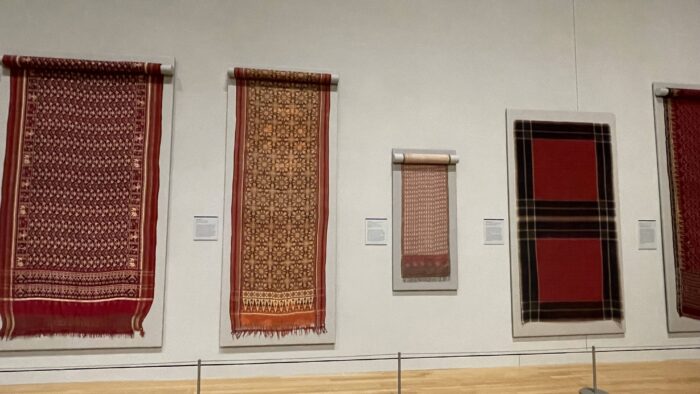From the Patan Patola sarees of Gujarat to the Pochampalli of Telangana to the Sambhalpuri of Odisha, Ikat has carved a niche in the textile traditions of India. One of the earliest evidence of this tye-and-dye craft comes from the murals of Ajanta dating almost a thousand years ago. The popularity and uniqueness of Ikat can be attributed to the meticulous process, in which resist is applied to the yarn before it is dyed and then woven. This results in the ‘blurriness,’ around the motifs and geometric patterns woven into the garment, making it a distinctive feature of Ikat weaves.
The threads of Ikat have also woven communities and cultures together since ancient times. Ikat from India travelled far and wide to Southeast Asia, influencing weaving patterns in the region as well as determining trade and commerce. It is also possible that Ikat weaves and craftsmanship travelled west to Egypt, Central Asia and West Asia via the Western trade routes.
A recent exhibition at the George Washington University Museum and The Textile Museum, Washington DC, titled ‘Irresistible: The Global Patterns of Ikat’ offers insights into Ikat’s sociocultural, creative and economic importance. While the exhibits included Ikats from Guatemala, Africa, Turkey, Greece, Uzbekistan, China, Japan and a few other countries, it is Ikats from Southeast Asia that found the closest resemblance to India.
In Indonesia, imported Indian Ikat became a priced commodity during colonial rule when the Dutch East Indies company traded Ikats in exchange for spices. However, the trade of textiles by merchants and the accompanying knowledge of design, weaving, dying etc was possibly prevalent even in pre-colonial times, given the deep civilizational connection between the two countries. Many Indonesian ethnic groups and tribes wove Ikats influenced from India, particularly Gujarat. Tenganan, in Bali, is the most prominent and the country’s only textile center where double Ikat is woven with some motifs directly borrowed from Patola. Only noblemen and women wore these clothes, especially during sacred ceremonies and festivities.

(Luka Semba, Indonesia. Credits: George Washington University Museum and The Textile Museum)
Similarly, the Lio community of Indonesia weaves the luka semba, a shawl-like garment that is worn by the elder members of village council. The garment also draws inspiration from Patola with repeating motifs in the center, triangular shapes in the border and two end panels, similar to the pallu of the Indian saree. As the exhibition highlighted, the luka semba is also preserved as sacred heirlooms after they are presented as offerings to the guardian and ancestral spirits.
Indian Ikat also became popular in Ayutthaya, Thailand where silk Patola and cotton Ikats were heavily in demand. The colourful Pha Lai Yang, commissioned for the nobility first and later made available in Thai markets bore similarities to Indian designs and motifs while being customised to Thai culture. For instance, they held figurative images of prom si na or four-faced Brahma, Vishnu riding on Garuda or kirttimukha. Later, in the 17th century, the English and the Dutch continued engaging in the textile trade and also commissioned Patola for the Thai King. Some of the imported Indian textiles were also re-exported to the neighbouring countries of China and Japan.

(Sampot Hol, Cambodia. Credits: George Washington University Museum and The Textile Museum)
The popularity of Patola spread to Cambodia and the Philippines as well, as was evidenced by the beautiful display of fabrics from these countries at The Textile Museum at George Washington University. From Cambodia, the exhibits included the Sampot Hol, a garment wrapped around the hip. Woven by local weavers in silk using the weft Ikat technique, this garment has two borders, two end panels and a central design, much like the Indian Ikat sarees. Alternating blocks of green and yellow, superimposed with red crosses, are called nar or the guard stripes that frame the side borders. The end panels also depicted rows of candelabra-like forms with pyramidical bases and bird-like motifs. ‘The designs are often interpreted as yantra motifs intended to protect from physical and spiritual harm’.
The Ikats displayed from the Philippines included a woman’s sarong woven by the Mandaya women and another woven by the Maranao community. While belonging to the same island of Mindanao, both the Mandaya and Marano weavers have distinct styles.

(Malong a Andon, the Philippines. Credits: George Washington University Museum and The Textile Museum)
The Maranao people specialised in weft Ikat. The exhibited sarong, known as malong a andon was made using silk, exclusively for women to wear during ceremonies and important occasions. The patterns bear close resemblance to the Indian Patola and so does the use of bright colours. Given the laborious and time-consuming weaving process, this garment holds high prestige and value in the community.

(Woman’s Sarong, the Philippines. Credits: George Washington University Museum and The Textile Museum)
On the other hand, the Mandaya community employs the warp Ikat technique and the fabric is dyed in natural colours of red, black and brown. A common belief amongst the Mandaya community is that Tagamaling, the guardian spirit associated with life and creation imparted the knowledge of weaving and designs, thus making Ikats a sacred garment. These warp Ikats are made from cultivated fibers of abaca, a type of banana tree. The belief also finds parallels in India, where Sage Markendeya is regarded as the first masterweaver, weaving clothes for the gods from lotus fibers and also teaching the skill of silk weaving to artisans in the temple town of Kanchipuram, India.
Furthermore, the practice of weaving has also served as a means of sharing lived experiences and preserving cultures in both India and the Philippines. In teaching about iconography, processes and technicalities of weaving to the younger generation, older Mandaya women pass down local folklore, history and cultural traditions.
Indian Ikats, valued for their advanced craftsmanship and technical expertise, have had a profound impact across Southeast Asia. Philosophies, means of creative expression and beliefs also travelled along with designs and motifs from India, finding adaptations locally, thus building a lasting shared legacy of this textile craft. Furthermore, owing to its popularity and high demand across social groups–from the nobility to the commoners–Ikats were also a lucrative trade item across the East and West trade routes. This economic and aesthetic significance of Indian Ikats led to a flourishing exchange between India and Southeast Asian countries, reinstating the deep cultural ties between the two regions.
Content courtesy: Photos and the supporting textual information, unless mentioned specifically, are taken from the exhibition ‘Irresistible: The Global Patterns of Ikat’ by the author during her visit to the George Washington University Museum and The Textile Museum, Washington DC, USA.





